Airline Lost Your Luggage? Help Them Find It Faster & More Reliably!
Web: www.stevenfrischling.com — E-Mail: fish@flyingwithfish.com
4/08/09 – Airline Lost Your Luggage? Help Them Find It Faster & More Reliably!
Most travellers never give baggage identification a second thought until their bags have been misplaced by an airline. As we enter the peak leisure travel season in many parts of the world, north of the equator, I wanted to revisit this topic with some simple advice for helping an airline locate your misplaced luggage should you become separated from it while in transit.
Airlines misplace luggage, delay luggage, misroute luggage, its a fact. It may be an irritating fact, but it is a fact. While the overall industry average statistic of approximately 0.5% of bags a becoming misrouted or misplaced is not that many bags statistically, that statistic still equals roughly 5,000 bags per 1,000,000 bags handled by airlines.
So when your 22″ black ballistic nylon roll-aboard bag is misrouted by the airline, how can you ensure your bag is quickly found and returned to you? Through clear baggage identification markings and multiple-redundant contact information being placed on the exterior of your bag.
I rarely check my bags, but there are times I have to for a variety of reasons. When I travel 99.9% of the time it is on business and I am in a location less than a day, so the contents of my bags tend to be critical to my travel. If a bag is delayed I don’t have time to wait, so I make sure they are extremely easy to identify so the airline can locate the bag quickly. Baggage is a functional tool, not a fashion piece, and my labeling of my bags makes this very clear.
All to often I have stood in the baggage office and listened to passengers try and describe their bag. It is almost always “Well my bag is black, ballistic nylon, it’s a rolling bag and it has an airline luggage tag on it.” Well good luck getting that bag sorted out quickly.
While my bags are almost all black ballistic nylon bags they are identified in such a way that it is nearly impossible for an airline to not be able to quickly identify my bag and return it to me. How do I do this? Most of my bags are labeled in the following way:
– Place unique markings on your bag. A red ribbon or red yarn is NOT unique; my bags are marked extensively in bright flamingo pink duct tape, and flamingo pink reflective tape.
– Place a standard laminated business card or easy to read ID tag on the handle. This tag should have your full name, phone numbers you can be reached at and an e-mail address.
– Place a business card in the bag’s ID card-slot (if that bag has one)
– Place a white or light coloured strip of duct tape inside the bag with you name, phone numbers and e-mail. Some of my bags have this tape identification twice just to be safe. Generally I place this info on the top lid of the bag or on the interior bag wall of the bag.
– Clearly write your contact info on a large easy to find spot strip of duct tape in at least two locations outside your bag.
– Place bright tape on all the handles, zippers, or surfaces as a further way to make ID’ing the bag easier for those in the baggage office when I describe the bag to them.
In addition to writing my contact information on strips of tape, a less conventional (and extremely effective) method I use for labeling certain black ballistic nylon bags is placing my contact information directly on my bags with bright paint markers.
When writing my contact information directly onto my bags I use bright yellow paint marker ink (it does not fade easily from ballistic nylon) and make sure my full name, phone number and e-mail are written in clear large letters/numbers on multiple sides of the bags. For added easy identification bags that I write my contact information on also have my ‘Fish Family’ drawn onto them (as seen in the photos below).
While many travellers don’t want to ‘ruin their bags with tape,’ and some business travellers are more concerned with appearances rather than practically, I am more focused on making sure my bags are clearly identifiable, but also returnable should they become separated from me in transit.
As an added bonus, airport thieves have no interest in baggage that doesn’t blend in with the crowd. A bag that is extremely easy to identify at 100 yards is not a bag they’re likely to try and steal.
So before you place an airline supplied paper baggage tag on your luggage, consider a better alternative to becoming reunited with your baggage quickly and reliable should it not end up on the same flight as you.
Below are 4 photos of my LL Bean roll-aboard bag and LowePro Pro Roller II bag and how they are marked for easy identification.
Happy Flying!
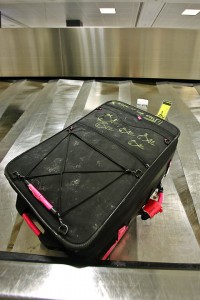
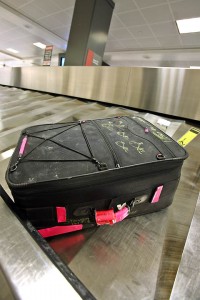
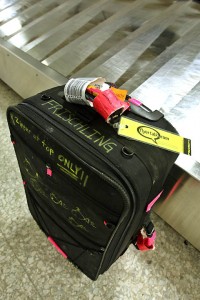
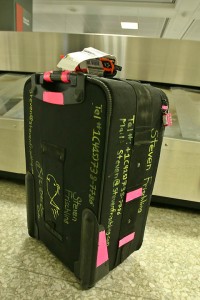
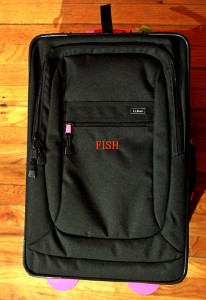
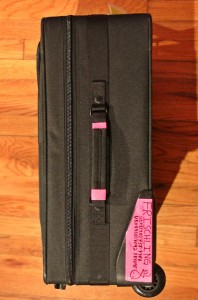
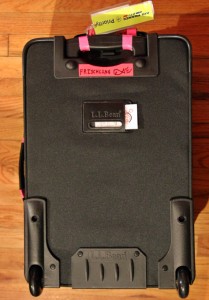
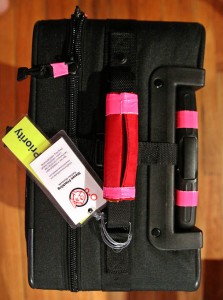
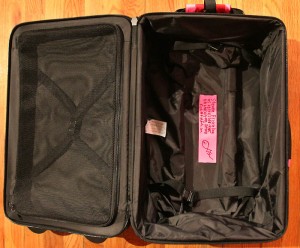


These are great suggestions, which I will incorporate on my trip this weekend. Can’t wait to look for the florescent duct tape. Source?
Here are a few more tips: http://tinyurl.com/RMcBAGS
Check out http://www.tapebrothers.com for a wide selection of tapes in more colour/tape-type options than you could possibly imagine. It’s the Disney World of tape.
Happy Flying!
-Fish
One more thing- take a photo of your luggage before you leave the house. Then at least if you have your camera you can email the airline the photo so they can match it. Useful for ports where English is not the first language- as they say, a picture is worth a thousand words! 😛